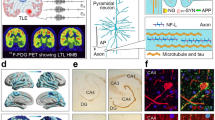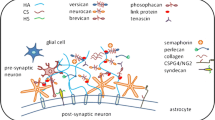Abstract
Gelsolin is an actin regulatory protein that generally distributed in a wide variety of body tissues, especially the brain tissues and cerebrospinal fluid. In this study we found that lumbar CSF-gelsolin concentrations markedly decreased in epileptic patients by enzyme linked immunosorbent assay. In order to help judge the result, we determined gelsolin expression in temporal lobe tissues of patients with temporal lobe epilepsy using double-label immunofluorescence to location and using western blot to quantitation. Then we observed that gelsolin was co-expressed with microtubule-associated protein-2 in axons and cytoplasms of neurons and gelsolin protein level was also down-regulated in temporal lobe tissues of epileptic patients. Our findings suggested that CSF-gelsolin level might reflect the alteration of gelsolin in brain tissue of epileptic patients and CSF-gelsolin seems to be a potential biomarker for epilepsy.




Similar content being viewed by others
References
Smith D, Defalla BA, Chadwick DW (1999) The misdiagnosis of epilepsy and the management of refractory epilepsy in a specialist clinic. QJM 92:15–23
Benbadis S (2009) The differential diagnosis of epilepsy: a critical review. Epilepsy Behav 15:15–21
Kanner AM, Morris HH, Luders H et al (1990) Supplementary motor seizures mimicking pseudoseizures: some clinical differences. Neurology 40:1404–1407
Hinson VK, Haren WB (2006) Psychogenic movement disorders. Lancet Neurol 5:695–700
Sato M, Yamauchi T (1993) Biological study on pathophysiology of epilepsy: secondary brain disorders following ictus. Jpn J Psychiatry Neurol 47:223–224
Brunnstrom H, Rawshani N, Zetterberg H et al (2010) Cerebrospinal fluid biomarker results in relation to neuropathological dementia diagnoses. Alzheimers Dement 6:104–109
Matsumoto N, Kitayama H, Kitada M et al (2003) Isolation of a set of genes expressed in the choroid plexus of the mouse using suppression subtractive hybridization. Neuroscience 117:405–415
Ohnishi M, Matsumoto T, Nagashio R et al (2009) Proteomics of tumor-specific proteins in cerebrospinal fluid of patients with astrocytoma: usefulness of gelsolin protein. Pathol Int 59:797–803
Nag S, Ma Q, Wang H et al (2009) Ca2+ binding by domain 2 plays a critical role in the activation and stabilization of gelsolin. Proc Natl Acad Sci USA 106:13713–13718
Li GH, Arora PD, Chen Y, et al (2011) Multifunctional roles of gelsolin in health and diseases. Med Res Rev 31: n/a. doi:10.1002/med.20231
Sun HQ, Yamamoto M, Mejillano M et al (1999) Gelsolin, a multifunctional actin regulatory protein. J Biol Chem 274:33179–33182
Kwiatkowski DJ, Stossel TP, Orkin SH et al (1986) Plasma and cytoplasmic gelsolins are encoded by a single gene and contain a duplicated actin-binding domain. Nature 323:455–458
Yin HL, Stossel TP (1979) Control of cytoplasmic actin gel-sol transformation by gelsolin, a calcium-dependent regulatory protein. Nature 281:583–586
McGough AM, Staiger CJ, Min JK et al (2003) The gelsolin family of actin regulatory proteins: modular structures, versatile functions. FEBS Lett 552:75–81
Janmey PA, Iida K, Yin HL et al (1987) Polyphosphoinositide micelles and polyphosphoinositide-containing vesicles dissociate endogenous gelsolin-actin complexes and promote actin assembly from the fast-growing end of actin filaments blocked by gelsolin. J Biol Chem 262:12228–12236
Yin HL, Albrecht JH, Fattoum A (1981) Identification of gelsolin, a Ca2+ -dependent regulatory protein of actin gel-sol transformation, and its intracellular distribution in a variety of cells and tissues. J Cell Biol 91:901–906
Meerschaert K, De Corte V, De Ville Y et al (1998) Gelsolin and functionally similar actin-binding proteins are regulated by lysophosphatidic acid. EMBO J 17:5923–5932
Forscher P, Smith SJ (1988) Actions of cytochalasins on the organization of actin filaments and microtubules in a neuronal growth cone. J Cell Biol 107:1505–1516
Bridgman PC, Dailey ME (1989) The organization of myosin and actin in rapid frozen nerve growth cones. J Cell Biol 108:95–109
Furnish EJ, Zhou W, Cunningham CC et al (2001) Gelsolin overexpression enhances neurite outgrowth in PC12 cells. FEBS Lett 508:282–286
Hartwig JH, Chambers KA, Stossel TP (1989) Association of gelsolin with actin filaments and cell membranes of macrophages and platelets. J Cell Biol 108:467–479
Koya RC, Fujita H, Shimizu S et al (2000) Gelsolin inhibits apoptosis by blocking mitochondrial membrane potential loss and cytochrome c release. J Biol Chem 275:15343–15349
Paunio T, Kangas H, Heinonen O et al (1998) Cells of the neuronal lineage play a major role in the generation of amyloid precursor fragments in gelsolin-related amyloidosis. J Biol Chem 273:16319–16324
Dong JH, Ying GX, Liu X et al (2006) Lesion-induced gelsolin upregulation in the hippocampus following entorhinal deafferentation. Hippocampus 16:91–100
Cunningham CC, Stossel TP, Kwiatkowski DJ (1991) Enhanced motility in NIH 3T3 fibroblasts that overexpress gelsolin. Science 251:1233–1236
Witke W, Sharpe AH, Hartwig JH et al (1995) Hemostatic, inflammatory, and fibroblast responses are blunted in mice lacking gelsolin. Cell 81:41–51
Gehrmann J, Matsumoto Y, Kreutzberg GW (1995) Microglia: intrinsic immuneffector cell of the brain. Brain Res Brain Res Rev 20:269–287
Vouyiouklis DA, Brophy PJ (1997) A novel gelsolin isoform expressed by oligodendrocytes in the central nervous system. J Neurochem 69:995–1005
Westberg JA, Zhang KZ, Andersson LC (1999) Regulation of neural differentiation by normal and mutant (G654A, amyloidogenic) gelsolin. FASEB J 13:1621–1626
Roth LW, Bormann P, Wiederkehr C et al (1999) Beta-thymosin, a modulator of the actin cytoskeleton is increased in regenerating retinal ganglion cells. Eur J Neurosci 11:3488–3498
Ji L, Chauhan A, Chauhan V (2010) Upregulation of cytoplasmic gelsolin, an amyloid-beta-binding protein, under oxidative stress conditions: involvement of protein kinase C. J Alzheimers Dis 19:829–838
Seino M (2006) Classification criteria of epileptic seizures and syndromes. Epilepsy Res 70(Suppl 1):S27–S33
Lu Y, Xue T, Yuan J et al (2009) Increased expression of TGFbeta type I receptor in brain tissues of patients with temporal lobe epilepsy. Clin Sci (Lond) 117:17–22
Gardiner J, Marc J (2010) Disruption of normal cytoskeletal dynamics may play a key role in the pathogenesis of epilepsy. Neuroscientist 16:28–39
Roth SU, Sommer C, Mundel P et al (2001) Expression of synaptopodin, an actin-associated protein, in the rat hippocampus after limbic epilepsy. Brain Pathol 11:169–181
Xiao F, Wang XF, Li JM et al (2008) Overexpression of N-WASP in the brain of human epilepsy. Brain Res 1233:168–175
Luo J, Xu Y, Zhu Q, et al (2011) Expression pattern of Mical-1 in the temporal neocortex of patients with intractable temporal epilepsy and pilocarpine-induced rat model. Synapse 65:n/a. doi:10.1002/syn.20961
Goncalves AF, Dias NG, Moransard M et al (2010) Gelsolin is required for macrophage recruitment during remyelination of the peripheral nervous system. Glia 58:706–715
Rashevsky N (1972) A neural circuit which exhibits some features of epileptic attacks. Bull Math Biophys 34:71–78
Spencer SS (2002) Neural networks in human epilepsy: evidence of and implications for treatment. Epilepsia 43:219–227
Percha B, Dzakpasu R, Zochowski M et al (2005) Transition from local to global phase synchrony in small world neural network and its possible implications for epilepsy. Phys Rev E Stat Nonlin Soft Matter Phys 72:031909
Furukawa K, Fu W, Li Y et al (1997) The actin-severing protein gelsolin modulates calcium channel and NMDA receptor activities and vulnerability to excitotoxicity in hippocampal neurons. J Neurosci 17:8178–8186
Armijo JA, de las Cuevas I, Adin J (2000) Ion channels and epilepsy. Rev Neurol 30(1):S25–S41
Pottiez G, Sevin E, Cecchelli R et al (2009) Actin, gelsolin and filamin-A are dynamic actors in the cytoskeleton remodelling contributing to the blood brain barrier phenotype. Proteomics 9:1207–1219
van Vliet EA, da Costa Araujo S, Redeker S et al (2007) Blood-brain barrier leakage may lead to progression of temporal lobe epilepsy. Brain 130:521–534
Hauptman JS (2010) From the bench to the bedside: Breaking down the blood-brain barrier, decoding the habenula, understanding hand choice, and the role of ketone bodies in epilepsy. Surg Neurol Int 1:86
Tomkins O, Feintuch A, Benifla M et al (2011) Blood-brain barrier breakdown following traumatic brain injury: a possible role in posttraumatic epilepsy. Cardiovasc Psychiatry Neurol 2011:765923
Hu Y, Huang Y, Quan F et al (2010) Comparison of the retention rates between carbamazepine and valproate as an initial monotherapy in Chinese patients with partial seizures: a ten-year follow-up, observational study. Seizure 20:208–213
Aroniadou-Anderjaska V, Fritsch B, Qashu F et al (2008) Pathology and pathophysiology of the amygdala in epileptogenesis and epilepsy. Epilepsy Res 78:102–116
Hoshikawa Y, Kwon HJ, Yoshida M et al (1994) Trichostatin A induces morphological changes and gelsolin expression by inhibiting histone deacetylase in human carcinoma cell lines. Exp Cell Res 214:189–197
Yildirim F, Gertz K, Kronenberg G et al (2008) Inhibition of histone deacetylation protects wildtype but not gelsolin-deficient mice from ischemic brain injury. Exp Neurol 210:531–542
Kulakowska A, Drozdowski W, Sadzynski A et al (2008) Gelsolin concentration in cerebrospinal fluid from patients with multiple sclerosis and other neurological disorders. Eur J Neurol 15:584–588
Lovell MA, Lynn BC, Xiong S et al (2008) An aberrant protein complex in CSF as a biomarker of Alzheimer disease. Neurology 70:2212–2218
Piubelli C, Fiorini M, Zanusso G et al (2006) Searching for markers of Creutzfeldt-Jakob disease in cerebrospinal fluid by two-dimensional mapping. Proteomics 6(1):S256–S261
Acknowledgments
This work was supported by grants from National Natural Science Foundation of China (NO. 30870877). We thank Xuanwu Hospital of Capital Medical University, Guangzhou 39 Brain Hospital, Xinhua Brain Hospital of Hubei Province, Xinqiao Hospital of the Third Military Medical University for their support in brain tissue collection. We also thank the patients for their participation in this study. We confirm that we have read the Journal’s position on issues involved in ethical publication and affirm that this report is consistent with those guidelines.
Author information
Authors and Affiliations
Corresponding author
Additional information
Xi Peng and Xiaogang Zhang contributed equally to this work.
Rights and permissions
About this article
Cite this article
Peng, X., Zhang, X., Wang, L. et al. Gelsolin in Cerebrospinal Fluid as a Potential Biomarker of Epilepsy. Neurochem Res 36, 2250–2258 (2011). https://doi.org/10.1007/s11064-011-0549-4
Received:
Revised:
Accepted:
Published:
Issue Date:
DOI: https://doi.org/10.1007/s11064-011-0549-4




